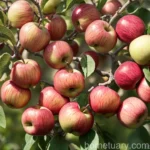Crabapple (Malus ‘Amerspirzam’ AMERICAN SPIRIT): A Complete Guide
Introduction
Crabapples are small- to medium-sized deciduous trees known for their stunning ornamental value, and the ‘Amerspirzam’ AMERICAN SPIRIT crabapple variety is no exception. This beautiful tree boasts a plethora of characteristics that make it a popular choice for landscaping and gardens. In this comprehensive guide, we will delve into the intricacies of this captivating Malus cultivar – from its cultural requirements to its uses, diseases, and more.
What is Crabapple (Malus ‘Amerspirzam’ AMERICAN SPIRIT)?
Crabapple Tree
The crabapple tree (Malus) is a genus of about 30–55 species of small deciduous apple trees or shrubs in the family Rosaceae. These trees are prized for their attractive blossoms, vibrant foliage, and in some cases, small edible fruits. They are widely cultivated for their ornamental value and can be found in various landscapes, gardens, and parks.
Malus ‘Amerspirzam’ AMERICAN SPIRIT
Malus ‘Amerspirzam’, commonly known as the AMERICAN SPIRIT crabapple, is a popular cultivar within the Malus genus. It is renowned for its profusion of stunning pink buds that open to fragrant, single, pure white blooms. This variety sets small, persistent, dark red fruit that provides winter interest and food for birds. Its exceptional features make it a sought-after choice for adding color and interest to landscapes.
Key Takeaways – crabapple (Malus ‘Amerspirzam’ AMERICAN SPIRIT)
Before we delve into the various aspects of the AMERICAN SPIRIT crabapple, let’s highlight some key takeaways about this captivating cultivar:
- Stunning pink buds open to fragrant, single, pure white blooms
- Small, persistent, dark red fruit provides winter interest and food for birds
- Highly valued for its ornamental value and ability to enhance landscapes
Now, let’s explore the cultural requirements, uses, and care tips for the AMERICAN SPIRIT crabapple.
Culture
Water
Proper watering is crucial for the health and vitality of crabapple trees. While they are generally quite adaptable to different soil types, ensuring an adequate and consistent water supply is important, especially during periods of drought. Young trees may require more frequent watering to establish strong root systems. It is recommended to water deeply, allowing the soil to dry out slightly between watering sessions.
Sunlight
Crabapple trees thrive in full sun to partial shade. For optimal bloom and fruit production, they should ideally receive at least six hours of direct sunlight daily. When selecting a planting location, consider the amount of sunlight the area receives throughout the day to ensure suitable conditions for the tree.
Fertilizer
Fertilizing crabapple trees can contribute to improved growth and blooming. Opt for a balanced fertilizer specifically formulated for fruit trees, applying it in early spring before new growth appears. Over-fertilization should be avoided, as it can lead to excessive vegetative growth and potential issues with disease susceptibility. Always follow the manufacturer’s instructions and consider soil testing for precise nutrient management.
Soil
Crabapple trees are relatively adaptable to different soil types, though they prefer well-draining, fertile soil. They can tolerate slightly acidic to slightly alkaline soil conditions, making them versatile in various landscapes. Conduct a soil test to determine the pH and nutrient levels of the planting area, and make any necessary amendments to create an optimal growing environment for the tree.
Pruning
Pruning is an essential aspect of crabapple tree care. It serves to shape the tree, remove dead or diseased wood, and promote better air circulation within the canopy. Pruning should be performed during the dormant season to minimize stress on the tree and reduce the risk of disease transmission. Additionally, the removal of water sprouts and suckers can help maintain the tree’s aesthetics and health.
Propagation
Crabapple trees can be propagated through various methods, including grafting, softwood cuttings, and seed propagation. Grafting onto suitable rootstock is a common practice for the propagation of specific cultivars, ensuring the preservation of desired traits. Softwood cuttings can be taken in early summer, while seeds collected from ripe fruit can be sown in the fall for new tree production.
Container Popularity
The AMERICAN SPIRIT crabapple, with its compact size and stunning visual appeal, is well-suited for container cultivation. This makes it an excellent choice for small gardens, urban landscapes, and patio settings. When grown in containers, it is essential to provide adequate drainage, water, and nutrients to support healthy growth and development.
Uses
Ornamental Value
The AMERICAN SPIRIT crabapple is primarily valued for its exceptional ornamental characteristics. From its stunning blooms to its dark red fruits and vibrant foliage, this cultivar adds beauty and interest to landscapes and gardens. Its compact size and striking appearance make it an ideal choice for focal points, borders, and mixed plantings.
Wildlife Habitat
Crabapple trees, including the AMERICAN SPIRIT cultivar, play a vital role in supporting wildlife. The fruits they produce serve as a valuable food source for birds, particularly during the winter months. By planting crabapples, individuals can contribute to creating a habitat that supports biodiversity and sustains various wildlife species.
Common Diseases
Disease Diagnosis
Crabapple trees can be susceptible to various diseases, with common issues including apple scab, cedar-apple rust, powdery mildew, and fire blight. Careful monitoring of the tree for symptoms such as leaf spots, discoloration, or abnormal growth can aid in early disease detection. Proper cultural practices, such as adequate spacing and good air circulation, can help mitigate disease pressure.
Common Pests
Pest Management
In addition to diseases, crabapple trees may also face challenges from pests such as aphids, caterpillars, and scale insects. Regular inspection of the tree for signs of pest activity, including distorted leaves, honeydew, or visible insects, is essential for prompt pest management. Natural predators, insecticidal soaps, and horticultural oils can offer effective control options for many pest species.
Botanist’s Tips
Crabapple trees, including the AMERICAN SPIRIT cultivar, provide numerous opportunities for unique and captivating landscape designs. Whether used as solitary specimens, mass plantings, or integrated into mixed borders, their ornamental value and seasonal interest make them versatile additions to diverse settings. To enhance the overall aesthetic appeal and health of crabapple trees, consider the following botanist’s tips:
- Select suitable cultivars based on desired traits, such as bloom color, fruit characteristics, and growth habit
- Incorporate companion plantings to complement and accentuate the crabapple’s features
- Utilize creative pruning and shaping techniques to create visually appealing tree forms
Fun Facts
To further appreciate the AMERICAN SPIRIT crabapple, let’s explore some fun and intriguing facts about this captivating cultivar:
- It is known for its exceptional cold hardiness and adaptability to various climatic conditions
- The name ‘AMERICAN SPIRIT’ pays homage to its American origin and enduring patriotic symbolism
- The vibrant pink buds and fragrant white blooms make it a popular choice for creating stunning spring displays
Links to External Resources
For further information on crabapple trees and the AMERICAN SPIRIT cultivar, explore the following external resources:
- Crabapples and More: A Guide to Selection and Use
- Malus ‘American Spirit’ – American Pillar™ Crabapple
In conclusion, the crabapple (Malus ‘Amerspirzam’ AMERICAN SPIRIT) stands as a testament to the enduring beauty and value of ornamental trees. Its exceptional ornamental qualities, adaptability, and ecological contributions make it a treasured addition to landscapes and gardens. By understanding its cultural requirements, uses, and care tips, individuals can fully appreciate and harness the unique allure of this captivating crabapple cultivar.















